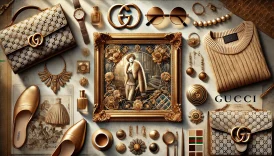Who Inspired the Story of Gucci?

- Who Inspired the Story of Gucci?
- The Founding of Gucci
- Family Dynamics and Influence
- Guccio Gucci: The Visionary
- Early Years in Florence
- Transition to Luxury Goods
- Patrizia Reggiani: The Controversial Figure
- Iconic Collaborations and Inspirations
- Influence of Celebrity Culture
- Artistic Directions and Creative Directors
- The Legacy of Gucci
- Frequently Asked Questions
The story of Gucci is not just about luxury fashion; it’s a tapestry woven with ambition, creativity, and a touch of scandal. The brand’s journey is influenced by a myriad of personalities who have left their mark on its identity. From its humble beginnings to becoming a household name, Gucci’s narrative is rich with inspiration drawn from various sources, including family dynamics, cultural experiences, and even the glitzy world of celebrity. Each figure involved has contributed uniquely to what we now recognize as one of the most iconic fashion houses in the world.
At the heart of Gucci’s story is Guccio Gucci, the visionary founder who laid the groundwork for this illustrious brand. His passion for craftsmanship and luxury was ignited during his formative years in Florence, a city renowned for its art and culture. This influence is evident in Gucci’s designs, which often reflect the elegance and sophistication of Italian heritage. But it doesn’t stop there; the Gucci saga also features Patrizia Reggiani, a controversial figure whose dramatic life intertwined with the brand’s legacy, adding layers of intrigue and complexity.
Moreover, the evolution of Gucci has been significantly shaped by collaborations and creative directors who brought their unique visions to the table. For instance, the impact of celebrity culture cannot be overlooked. Stars have donned Gucci on red carpets, elevating the brand’s status and making it synonymous with glamour and prestige. This interplay between celebrity and fashion has created a feedback loop that continually inspires both the brand and its audience.
| Key Influencers | Impact on Gucci |
|---|---|
| Guccio Gucci | Founded the brand with a vision of luxury and craftsmanship. |
| Patrizia Reggiani | Added drama and intrigue to the brand’s narrative. |
| Tom Ford | Revitalized the brand in the 1990s with bold designs. |
| Alessandro Michele | Reimagined Gucci’s aesthetic, blending vintage and modern styles. |
As we delve deeper into the influences behind Gucci, it becomes clear that the brand’s story is a reflection of its time—an ever-evolving narrative that continues to inspire the fashion world today. The legacy of Gucci is not just about the products it creates but also about the stories, relationships, and cultural moments that have defined its path. So, who inspired the story of Gucci? It’s a question that invites exploration, revealing a rich tapestry of influences that continue to resonate in contemporary fashion culture.
The Founding of Gucci
In the heart of Florence, a dream began to take shape in the early 1920s, led by none other than Guccio Gucci. Born into a family of artisans, Guccio’s early experiences in the bustling world of luxury goods inspired him to create a brand that would redefine elegance. With a vision that combined craftsmanship and style, he laid the groundwork for what would become one of the most iconic fashion houses in the world.
Guccio’s journey started in London, where he worked at the prestigious Savoy Hotel, observing the affluent clientele and their refined tastes. This exposure ignited a passion for high-quality materials and exquisite design. Returning to Florence, he opened his first store in 1921, initially focusing on leather goods. His commitment to quality and attention to detail quickly set Gucci apart from its competitors.
As the brand grew, Guccio implemented a few key principles that would become synonymous with Gucci:
- Quality Craftsmanship: Each product was meticulously crafted, ensuring longevity and luxury.
- Timeless Design: Gucci’s aesthetic embraced both classic and contemporary styles, appealing to a wide range of customers.
- Innovation: Guccio was not afraid to experiment with new materials and designs, keeping the brand fresh and relevant.
By the 1930s, Gucci had established itself as a luxury brand, attracting notable clientele and gaining recognition. The iconic Gucci logo and the famous green-red-green stripe were introduced, solidifying the brand’s identity. These elements not only represented style but also signified a lifestyle that many aspired to achieve.
| Year | Milestone |
|---|---|
| 1921 | Guccio Gucci opens the first store in Florence. |
| 1930s | Introduction of the iconic Gucci logo and stripe. |
| 1947 | Launch of the first Gucci handbag, the “Bamboo Bag”. |
As we reflect on the founding of Gucci, it’s clear that Guccio’s vision was not just about creating a brand; it was about crafting a legacy. His ability to blend tradition with modernity has allowed Gucci to endure and evolve, maintaining its status as a leader in the fashion industry. The story of Gucci is a testament to the power of passion, innovation, and an unwavering commitment to quality.
Family Dynamics and Influence
The Gucci family is a tapestry woven with threads of ambition, rivalry, and creativity. From its inception, the dynamics within the family have played a crucial role in shaping the brand’s identity and direction. The relationships between family members have not only influenced the operational aspects of the company but have also impacted its creative vision. This intricate web of family ties often led to both collaboration and conflict, creating a unique atmosphere that propelled Gucci into the limelight.
At the heart of this family saga is Guccio Gucci, the founder, whose vision laid the groundwork for the luxury brand. His sons, Aldo, Vasco, and Rodolfo, each brought their own flair and ideas to the table. However, their differing visions often resulted in intense rivalries. For instance, Aldo was known for his business acumen and expansion strategies, while Rodolfo focused on the artistic side, leading to a classic clash of interests.
| Family Member | Role in Gucci | Influence |
|---|---|---|
| Guccio Gucci | Founder | Established the brand’s ethos |
| Aldo Gucci | Business Executive | Expanded the brand globally |
| Rodolfo Gucci | Creative Director | Focused on luxury and aesthetics |
As the brand grew, so did the complexity of the family dynamics. The internal struggles often spilled over into public view, leading to scandals that captured the media’s attention. One of the most infamous episodes involved Patrizia Reggiani, who married into the Gucci family and later became embroiled in a notorious scandal. Her story exemplifies how personal relationships can dramatically affect a brand’s reputation and legacy.
In summary, the family dynamics within Gucci are a significant chapter in the brand’s history. The interplay of ambition, rivalry, and creativity among family members has not only shaped the company’s trajectory but also left an indelible mark on the fashion industry as a whole. As we delve deeper into the story of Gucci, it’s essential to understand how these internal relationships have influenced the brand’s evolution over the decades.
"Family ties can be both a blessing and a curse; in the case of Gucci, they were a bit of both." - Fashion Historian
Guccio Gucci: The Visionary
Guccio Gucci was not just a name; he was a visionary whose dreams transformed a small leather goods workshop into a global fashion powerhouse. Born in Florence, Italy, in 1881, Guccio’s early experiences in the world of luxury shaped his future ambitions. He worked in London at the prestigious Savoy Hotel, where he observed the elegance of high society. This exposure ignited his passion for fine craftsmanship and luxury, leading him to return to Florence to establish his own brand.
Guccio’s vision was clear: he wanted to create products that embodied both functionality and style. His focus on quality materials and meticulous craftsmanship laid the groundwork for what would become the Gucci legacy. From the outset, he understood that luxury was not just about the product; it was about the experience it provided. This philosophy is evident in the brand’s iconic designs, which continue to resonate with fashion lovers today.
As he began to build his empire, Guccio relied heavily on the rich cultural influences of Florence. The city’s art, architecture, and history inspired his designs, which often featured intricate details and timeless elegance. For example, the famous Gucci green-red-green stripe was not merely a design choice; it was a nod to the Italian heritage and a symbol of luxury that would become synonymous with the brand.
However, Guccio’s journey was not without challenges. The fashion industry is notorious for its cutthroat competition, and Guccio had to navigate through various obstacles, including economic downturns and changing consumer preferences. Yet, his unwavering commitment to quality and innovation allowed him to thrive. He once famously said, “Quality is remembered long after the price is forgotten.” This quote encapsulates his belief in the value of enduring craftsmanship.
| Key Milestones in Guccio Gucci’s Life | Year |
|---|---|
| Birth in Florence | 1881 |
| Opened first shop | 1921 |
| First Gucci store in New York | 1953 |
| Guccio’s passing | 1953 |
In conclusion, Guccio Gucci was a true pioneer whose vision and dedication to excellence laid the foundation for one of the most iconic fashion brands in the world. His legacy continues to inspire designers and entrepreneurs alike, proving that a strong vision can indeed change the world.
Early Years in Florence
Guccio Gucci’s journey began in the stunning city of Florence, a place that would profoundly shape his vision and ambitions. Born into a family of artisans in 1881, Guccio was surrounded by the rich tapestry of Florentine culture, art, and craftsmanship. This environment was not just a backdrop; it was the very canvas that would inspire his future designs. From an early age, he was captivated by the intricate details of leatherwork and the elegance of fashion that permeated the streets of Florence.
Florence was a hub of creativity, with its stunning architecture and vibrant arts scene. Guccio’s formative years were filled with experiences that would later influence the iconic style of the Gucci brand. He often wandered through the bustling markets, absorbing the craftsmanship of local artisans. This exposure to high-quality craftsmanship instilled in him a deep appreciation for luxury and detail.
To understand Guccio’s early influences, we can look at key aspects of his life:
| Aspect | Influence on Guccio |
|---|---|
| Family Background | Raised in a family of artisans, he learned the value of craftsmanship. |
| Florentine Culture | Rich artistic environment that inspired his aesthetic choices. |
| Market Experiences | Exposure to luxury goods and craftsmanship shaped his business philosophy. |
In his youth, Guccio also worked in prestigious hotels in London, where he encountered the elite clientele that would later become his target market. This experience was pivotal, as it taught him the nuances of luxury service and the expectations of affluent customers. It was during these formative years that Guccio started to dream of creating a brand that would reflect the sophistication and elegance he had come to admire.
Ultimately, Guccio’s early years in Florence were not just about personal growth; they were the foundation upon which the Gucci legacy would be built. His experiences would later manifest in the luxurious designs and the iconic status of the brand he founded. As we explore the evolution of Gucci, it’s essential to remember that the roots of this legendary fashion house lie deeply embedded in the vibrant culture of Florence.
“Florence is not just a city; it’s a state of mind that shapes creativity.” – Anonymous
Transition to Luxury Goods
In the early 20th century, Guccio Gucci found himself at a crossroads, transitioning from a humble luggage maker to the visionary behind a luxury fashion empire. His experiences working at prestigious hotels in London and Paris exposed him to the world of high society and luxury goods. This pivotal moment was not just a career shift; it was the birth of a brand that would redefine elegance and sophistication.
Guccio’s time in these vibrant cities ignited a passion for craftsmanship and quality that would become synonymous with the Gucci name. He realized that the market was ripe for a brand that combined traditional Italian craftsmanship with modern luxury. This led to the creation of iconic products that were not only functional but also stylish. The transition was marked by several key elements:
- Quality Materials: Guccio sourced the finest leathers and fabrics, ensuring each product met the highest standards.
- Innovative Designs: He introduced unique designs that set Gucci apart from its competitors, such as the famous green-red-green stripe.
- Brand Identity: The establishment of the interlocking “G” logo became a symbol of prestige and exclusivity.
As the brand gained traction, it became a favorite among the elite, solidifying its place in the luxury market. The transition to luxury goods was not merely about products; it was about creating a lifestyle. Guccio understood that fashion was a form of self-expression, and he aimed to cater to a clientele that valued individuality and status.
In a quote that encapsulates his vision, Guccio once said, “Fashion is not something that exists in dresses only. Fashion is in the sky, in the street, fashion has to do with ideas, the way we live, what is happening.” This belief propelled Gucci into the spotlight, making it not just a brand, but a cultural phenomenon.
| Key Elements of Gucci’s Transition | Impact on Brand |
|---|---|
| Quality Materials | Established a reputation for luxury and durability. |
| Innovative Designs | Set trends and distinguished the brand from competitors. |
| Brand Identity | Created a recognizable symbol of prestige. |
Guccio Gucci’s transition to luxury goods not only transformed his career but also laid the foundation for a legacy that continues to inspire the world of fashion today. His journey is a testament to the power of vision and the relentless pursuit of excellence, reminding us that every great brand has a story worth telling.
Patrizia Reggiani: The Controversial Figure
Patrizia Reggiani, often referred to as the “Black Widow” of Gucci, is a name that evokes intrigue and controversy. Her life is a whirlwind of ambition, betrayal, and glamor, perfectly encapsulating the drama that surrounds the iconic fashion house. But what exactly makes her a controversial figure in the Gucci saga? Let’s dive into her story.
Born into a humble family, Patrizia’s rise to prominence began when she married Maurizio Gucci, the grandson of the brand’s founder, Guccio Gucci. Their marriage was a classic tale of love and ambition, but it soon spiraled into a chaotic narrative filled with personal and professional conflicts. As Maurizio took the reins of the Gucci brand, Patrizia’s influence grew, but so did her desire for power. She wanted to be more than just the wife of the heir; she wanted to shape the brand’s future.
However, their relationship deteriorated, leading to a bitter divorce that left Patrizia feeling betrayed and angry. In a shocking turn of events, she was implicated in a plot to murder Maurizio in 1995, a crime that would forever alter the Gucci legacy. This incident not only tarnished the Gucci name but also painted Patrizia as a villain in the eyes of the public.
| Event | Year | Impact |
|---|---|---|
| Marriage to Maurizio Gucci | 1972 | Increased influence in Gucci |
| Divorce from Maurizio Gucci | 1991 | Loss of power and wealth |
| Murder of Maurizio Gucci | 1995 | Imprisonment and notoriety |
Patrizia’s story raises numerous questions about loyalty, ambition, and the lengths one might go to reclaim power. Was her drastic action a result of desperation, or was it a calculated move in a high-stakes game? The line between love and hate can become blurred in the world of luxury and fame, and Patrizia’s life serves as a prime example of this tumultuous balance.
In the end, Patrizia Reggiani remains a controversial figure whose actions have left an indelible mark on the Gucci brand. Her story is a reminder that behind the glitz and glamor of fashion lies a complex web of human emotions and motivations.
Iconic Collaborations and Inspirations
When it comes to the world of luxury fashion, Gucci has consistently pushed boundaries through its iconic collaborations and inspirations. These partnerships have not only shaped the brand’s identity but also redefined the fashion landscape. From artists to filmmakers, Gucci has embraced a wide range of creative minds, each adding their unique flair to the brand’s narrative. One cannot overlook how these collaborations have resulted in collections that are both visually stunning and culturally resonant.
Take, for instance, the collaboration with renowned artist Guillermo del Toro, which brought a whimsical touch to Gucci’s collections. The interplay between fashion and art becomes a dialogue that resonates with consumers, creating pieces that are more than just clothing—they’re wearable art. Similarly, the partnership with Harry Styles has bridged the gap between music and fashion, showcasing how celebrity culture can elevate a brand’s status. Styles’ bold fashion choices have not only made headlines but have also inspired a new generation to embrace Gucci’s daring aesthetics.
Gucci has also made waves in the realm of digital collaborations, particularly with the rise of virtual fashion. The introduction of digital clothing lines has opened up a new frontier for the brand, allowing it to reach tech-savvy consumers who value innovation. This shift is a testament to Gucci’s adaptability in an ever-changing market, ensuring that it remains at the forefront of fashion trends.
| Collaboration | Influence | Year |
|---|---|---|
| Guillermo del Toro | Whimsical designs | 2018 |
| Harry Styles | Music and fashion fusion | 2019 |
| Digital Fashion | Innovation in luxury | 2020 |
In conclusion, the inspirations behind Gucci’s iconic collaborations are as diverse as the brand itself. Each partnership tells a story, reflecting the cultural zeitgeist while pushing the envelope of what luxury fashion can be. As we look to the future, it’s clear that Gucci will continue to draw inspiration from the world around it, ensuring its legacy remains vibrant and influential.
Influence of Celebrity Culture
The on Gucci is nothing short of transformative. Over the years, the brand has become synonymous with glamour and prestige, largely due to its association with high-profile celebrities. These iconic figures have not only worn Gucci on red carpets but have also become integral to the brand’s identity. Just think about it—when a star steps out in a Gucci gown, it’s not just a fashion statement; it’s a cultural moment that resonates with fans worldwide. This relationship between Gucci and celebrities has fueled a cycle of admiration and aspiration.
From Madonna to Beyoncé, and more recently, Harry Styles, the list of celebrities who have embraced Gucci is extensive. Their choices have elevated the brand’s status and created a buzz that transcends the fashion world. The impact of their endorsements is profound, often leading to increased sales and heightened visibility. For instance, the collaboration with Alessandro Michele brought a wave of youthful energy, attracting a new generation of fans eager to emulate their favorite stars.
| Celebrity | Notable Gucci Moment |
|---|---|
| Madonna | Wore a custom Gucci gown at the 2003 MTV Video Music Awards |
| Beyoncé | Sported a Gucci outfit during her historic Coachella performance |
| Harry Styles | Featured in a Gucci campaign, showcasing gender-fluid fashion |
Moreover, social media has amplified this influence. Platforms like Instagram and TikTok allow fans to see their favorite celebrities flaunting Gucci pieces in real-time, creating a sense of accessibility and desire. This digital exposure has turned the brand into a staple in pop culture, making it a must-have for those who want to stay trendy. In a world where fashion is constantly evolving, Gucci has managed to stay relevant by aligning itself with the stars that shape our cultural landscape.
In conclusion, the on Gucci is a testament to the power of fame in the fashion industry. As long as celebrities continue to shine in Gucci, the brand will remain a beacon of luxury and style, inspiring countless individuals to dream big and dress even bigger.
Artistic Directions and Creative Directors
The story of Gucci is not just about its luxurious products; it’s also woven with the creative visions of its artistic directors. Each director has brought their unique flair, steering the brand through various phases of innovation and style. From the bold designs of Tom Ford to the eclectic aesthetics of Alessandro Michele, Gucci’s artistic direction has always been a reflection of its time, resonating with fashion enthusiasts worldwide.
One of the most significant shifts in Gucci’s trajectory came with Tom Ford, who took the reins in the 1990s. Under his leadership, Gucci transformed from a struggling brand into a fashion powerhouse. Ford’s vision was characterized by a blend of sensuality and sophistication, which not only revitalized the brand but also set new trends in the luxury fashion market. His famous runway shows were a spectacle, often featuring striking visuals and a sense of drama that captivated audiences.
Following Ford, Frida Giannini continued the legacy by infusing a modern twist into Gucci’s classic designs. She emphasized the brand’s heritage while exploring new materials and patterns, making Gucci relevant to a younger generation. Giannini’s tenure saw the introduction of iconic pieces that became staples in luxury fashion, such as the Gucci Marmont bag.
Then came Alessandro Michele, whose appointment in 2015 marked a new era for Gucci. Michele’s vision was a radical departure from the past, embracing a more eclectic and maximalist approach. His designs often featured bold prints, vibrant colors, and a mix of vintage and contemporary styles. This artistic direction not only rejuvenated the brand’s image but also attracted a diverse clientele, making Gucci a cultural phenomenon.
| Creative Director | Tenure | Key Contributions |
|---|---|---|
| Tom Ford | 1994-2004 | Revitalized the brand with sensual designs and dramatic runway shows. |
| Frida Giannini | 2006-2015 | Modernized classic designs and introduced iconic products. |
| Alessandro Michele | 2015-Present | Embraced eclecticism and maximalism, attracting a diverse audience. |
In conclusion, the artistic directions and visions of these creative directors have not only shaped Gucci’s identity but have also left an indelible mark on the fashion industry. Their unique approaches have allowed Gucci to evolve while staying true to its luxurious roots, ensuring that the brand remains a symbol of elegance and innovation.
The Legacy of Gucci
The legacy of Gucci is not just a tale of luxury fashion; it’s a narrative woven into the fabric of global culture. Over the decades, Gucci has evolved from a small leather goods shop in Florence to a symbol of opulence and style recognized worldwide. This evolution is a testament to the brand’s ability to adapt while maintaining its core values of craftsmanship and innovation.
One of the most remarkable aspects of Gucci’s legacy is its ability to influence and be influenced. The brand has continuously drawn inspiration from various cultural movements, artistic expressions, and even societal changes. This dynamic interplay has allowed Gucci to remain relevant through the years, captivating the hearts of fashion enthusiasts across generations.
Furthermore, Gucci’s impact extends beyond fashion. The brand has played a pivotal role in shaping the luxury market, setting trends that others follow. Its collaborations with artists, musicians, and designers have not only enriched its offerings but also fostered a sense of community and creativity within the industry.
| Year | Event | Impact |
|---|---|---|
| 1921 | Founding of Gucci | Established a legacy of luxury |
| 1990s | Tom Ford’s Creative Direction | Revitalized the brand’s image |
| 2015 | Alessandro Michele’s Appointment | Introduced a new aesthetic, blending vintage with modern |
Gucci’s legacy is also characterized by its commitment to sustainability. In recent years, the brand has made significant strides toward eco-friendly practices, recognizing the importance of environmental responsibility in today’s world. This commitment not only enhances its brand image but also resonates with a more conscious consumer base.
As we look to the future, the question arises: what will the next chapter of Gucci’s legacy entail? With its rich history and innovative spirit, one can only imagine the exciting possibilities that lie ahead. Will Gucci continue to set the pace for luxury fashion, or will it redefine what luxury means in the modern era? Only time will tell, but one thing is certain: Gucci’s story is far from over.
“Fashion is about dreaming and making other people dream.” – Donatella Versace
Frequently Asked Questions
- Who founded the Gucci brand?
The Gucci brand was founded by Guccio Gucci in 1921. His vision and experience in the luxury goods industry laid the groundwork for what would become one of the most iconic fashion houses in the world.
- What role did Patrizia Reggiani play in Gucci’s history?
Patrizia Reggiani was a significant figure in the Gucci saga, known for her controversial influence on the brand. Her tumultuous relationship with the Gucci family and her notorious actions have made her a focal point in the brand’s narrative.
- How did Gucci transition from luggage to luxury fashion?
Guccio’s experiences in cities like London and Paris inspired him to pivot from crafting luggage to creating luxury fashion items, thus shaping Gucci’s future direction and success.
- What impact have celebrities had on Gucci?
Celebrity culture has played a massive role in popularizing Gucci. From endorsements to unforgettable red carpet moments, celebrities have significantly elevated the brand’s status and visibility.
- Who are some notable creative directors of Gucci?
Notable creative directors include Tom Ford and Alessandro Michele, both of whom have left a lasting impact on the brand’s evolution through their unique visions and artistic directions.
- What is the legacy of Gucci in the fashion industry?
Gucci’s legacy is profound, as it has continually influenced fashion trends and culture. The inspirations behind its story resonate strongly in contemporary fashion, making it a timeless brand.





